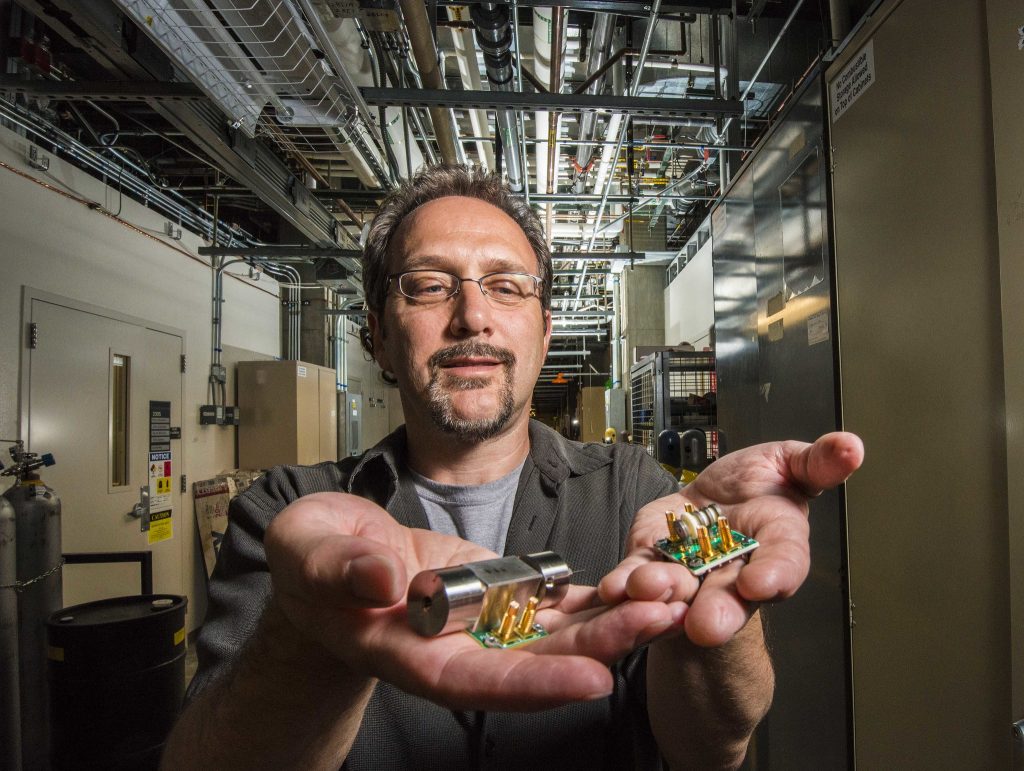Miniaturized Chemical Detectors for Point-of-Care Diagnosis
Sandia’s mini-PDID makes it possible to diagnose illnesses by identifying volatile organic compounds (VOCs) associated with certain diseases and infections on a patient’s breath or in the headspace of biological fluids

Building on decades of portable chemical analysis research, Sandia’s latest chemical detector, based on our miniaturized pulse-discharged ionization detector (mini-PDID), makes it possible to diagnose illnesses by identifying volatile organic compounds (VOCs) associated with certain diseases and infections on a patient’s breath or in the headspace of biological fluids. The Sandia system consists of a microfabricated sample preconcentrator, micro gas chromatography columns, and a miniaturized pulsed-discharge ionization detector. This system is sensitive enough to detect trace levels of analytes (parts per billion to parts per trillion range), making it possible to detect specific VOCs released by a pathogen, the patient, or both. This non-invasive diagnostic tool is inexpensive, portable, low-power, durable, and is designed for bed-side or field operation. It has the ability to produce rapid results, decreasing treatment costs and diagnosis cycle time.
The mini-PDID system has similar detection limits to gold standard mass spectrometers, but at a fraction of the size and cost. By creating a miniature version and improving its detection range, Sandia created a powerful detector for a wide range of field applications. The central technology in the chemical detection portfolio, the mini-PDID, is approximately 40- to 80- fold smaller than traditional PDIDs and mass spectrometers. The mini-PDID is directly integrated with a circuit board, has a unique electrode design, and is approximately the size of a D cell battery (1 inch by 1 inch by 2 inches). The device’s detector core is self-aligned and compressed during assembly, eliminating the need for adhesives, which degrade detector performance. In addition to its small size, it has the ability to detect a wide range of chemical compounds. When paired with the microPC-microGC subsystem, it can identify both patterns of VOCs and specific volatiles with high sensitivity. The microPC-microGCxGC subsystem provides sample collection of trace or transient analytes and robust separation which in turn reduces false alarms and ensures even complex chemical mixtures are separated. The novel flow-modulated subsystem utilizes gas pressure, which eliminates the need for cryogens required for thermal modulation. The GC columns are designed using thin membrane sealing structures that are only broken in a clean environment, ensuring the columns remain uncontaminated in their manufacturing process. The Sandia mini-PDID system has proven applications in chemical, biological and explosives (CBE) chemical detection and is currently being tested for veterinary disease diagnostic applications.
• Highly versatile, portable, lowpower POC system
• Detection range on the same scale as MS systems
• Identifies both patterns of VOCs and specific volatiles
• Rapid results
• Offers universal or selective detection
• Does not require expensive radioactive ionization source
• Continuous operation for up to 9 hours on mini 1” diameter by 5” long He tank
• Does not require trained/expert personnel to operate
• Disease biomarkers and diagnostics
• Neonatal monitoring
• Population biomonitoring
• Epidemiology
• Pharmaceuticals
• Monitoring wound health for infections
• Bacteria, viruses, toxins exposure
• Veterinary
SD#13055
Published8/3/2016
Last Updated3/29/2019